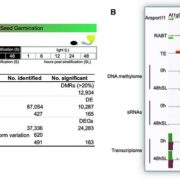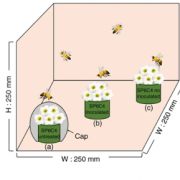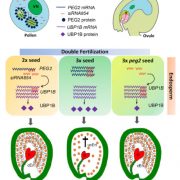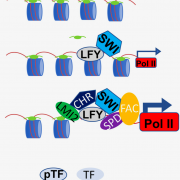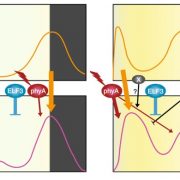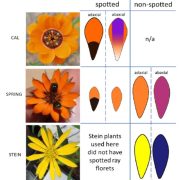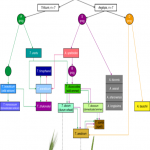Review: A fruitful journey: Pollen tube navigation from germination to fertilization ($)
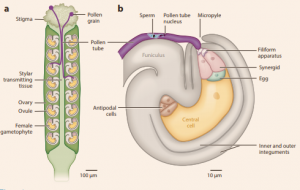 When pollen is deposited on a flower’s stigma, pollen tubes penetrate the stigma and elongate towards ovules where two non-motile sperm will double fertilize an egg and a central cell, which requires cooperation between many cell types. Johnson et al. review our current understanding of these processes. Ca2+ circuits mediate the signaling events that make pollen tube growth possible through involvement in cytoskeletal dynamics and regulating genes that encode proteins associated with Ca2+ signaling. LURE proteins work to attract pollen tube growth towards ovules and are species-specific to ensure the correct pollen tube reaches the ovule. Sperm is released when pollen tubes reach the filiform apparatus, a membrane-rich area within the ovule where signaling peptides accumulate along with other small molecules that facilitate pollen tube reception. Sperm fuses with the female gametes by way of HAP2–GCS1, a protein similar in function to the protein that allows some enveloped viruses to enter their hosts. Ca2+ signaling is highly susceptible to temperature stress, making the study of pollen tube growth especially pertinent in the face of increasing temperatures and extreme weather events as byproducts of climate change. (Summary by Rebecca Hayes). Annu. Rev. Plant Biol. 10.1146/annurev-arplant-050718-100133
When pollen is deposited on a flower’s stigma, pollen tubes penetrate the stigma and elongate towards ovules where two non-motile sperm will double fertilize an egg and a central cell, which requires cooperation between many cell types. Johnson et al. review our current understanding of these processes. Ca2+ circuits mediate the signaling events that make pollen tube growth possible through involvement in cytoskeletal dynamics and regulating genes that encode proteins associated with Ca2+ signaling. LURE proteins work to attract pollen tube growth towards ovules and are species-specific to ensure the correct pollen tube reaches the ovule. Sperm is released when pollen tubes reach the filiform apparatus, a membrane-rich area within the ovule where signaling peptides accumulate along with other small molecules that facilitate pollen tube reception. Sperm fuses with the female gametes by way of HAP2–GCS1, a protein similar in function to the protein that allows some enveloped viruses to enter their hosts. Ca2+ signaling is highly susceptible to temperature stress, making the study of pollen tube growth especially pertinent in the face of increasing temperatures and extreme weather events as byproducts of climate change. (Summary by Rebecca Hayes). Annu. Rev. Plant Biol. 10.1146/annurev-arplant-050718-100133


